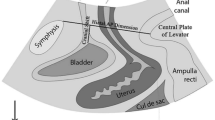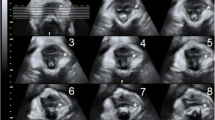Abstract
Introduction and hypothesis
Pelvic floor ultrasound is used as a validated technique for measuring levator ani dimensions. Vaginal manometry has been used in the past as a method to assess levator ani muscle (LAM) strength. Whether the combination of both methods can contribute to our understanding of pelvic floor pathophysiology has not yet been described. We hypothesized that as female pelvic floor muscular hiatus increases, the vaginal pressure and strength decrease.
Methods
We recruited 20 asymptomatic nulliparous women ages 18–85 years. Minimal levator hiatus (MLH) area, anteroposterior/left-right (AP/LR) diameter ratio, the distance between levator plate and the pubic symphysis (LP-PS) while at rest and squeeze were measured using endovaginal ultrasound (US). Vaginal pressure at rest, squeeze (Kegel) and Valsalva were measured using 3D manometry. Logistic and linear regression analysis was performed to assess correlations.
Results
MLH area was negatively correlated with the sum of all the squeeze pressures produced on the four walls of the vagina (p = 0.049, R2 = 0.197). There was also a borderline negative correlation between MLH and the sum of rest pressures (p = 0.09, R2 = 0.15). AP/LR ratio was negatively correlated with the sum of squeeze pressures (p = 0.056, R2 = 0.197). LP-PS distances, both while at rest and during squeeze, were negatively correlated with the vaginal squeeze pressure (p = 0.046, R2 = 0.21; p = 0.011, R2 = 0.31, respectively). LP-V distance, both at rest and during squeeze, was negatively correlated with the sum of squeeze pressures on four vaginal walls (p = 0.02, R2 = 0.25; p = 0.005, R2 = 0.36, respectively).
Conclusions
Stronger levator ani muscles, smaller MLH area and a more oval shape of pelvic floor hiatus as assessed by pelvic floor ultrasound are associated with higher squeeze vaginal pressures as assessed by 3D manometry.



Similar content being viewed by others
References
Rostaminia G, White DE, Quiroz LH, Shobeiri SA. Visualization of periurethral structures by 3D endovaginal ultrasonography in midsagittal plane is not associated with stress urinary incontinence status. Int Urogynecol J. 2013;24(7):1145–50. https://doi.org/10.1007/s00192-012-1990-x.
Denson L, Shobeiri SA. Imaging of urethral bulking agents: a Sonographer's perspective. J Diagnostic Med Sonography. 2013;29(6):255–9. https://doi.org/10.1177/8756479313506785.
Denson L, Shobeiri SA. Three-dimensional endovaginal sonography of synthetic implanted materials in the female pelvic floor. J Ultrasound Med. 2014;33(3):521–9. https://doi.org/10.7863/ultra.33.3.521.
Javadian P, Quiroz LH, Shobeiri SA. In vivo ultrasound characteristics of vaginal mesh kit complications. Female Pelvic Med Reconstruct Surg. 2017;23(2):162–7. https://doi.org/10.1097/SPV.0000000000000400.
Manonai J, Rostaminia G, Denson L, Shobeiri SA. Clinical and ultrasonographic study of patients presenting with transvaginal mesh complications. Neurourol Urodyn. 2016;35(3):407–11. https://doi.org/10.1002/nau.22725.
Shobeiri SA, Rostaminia G, White DE, Quiroz LH. The determinants of minimal levator hiatus and their relationship to the puborectalis muscle and the levator plate. Bjog. 2012;120(2):205–11. https://doi.org/10.1111/1471-0528.12055.
Van Delft K, Shobeiri SA, Sultan AH, Thakar R. Haematomas may masquerade as levator ani muscle defects. Int Urogynecol J. 2012;23(2):S43–S244.
Shobeiri SA, Leclaire E, Nihira MA, Quiroz LH, O'Donoghue D. Appearance of the levator ani muscle subdivisions in endovaginal three-dimensional ultrasonography. Obstet Gynecol. 2009;114:66–72.
van Delft K, Thakar R, Shobeiri SA, Sultan AH. Levator hematoma at the attachment zone as an early marker for levator ani muscle avulsion. Ultrasound Obstet Gynecol. 2014;43(2):210–7. https://doi.org/10.1002/uog.12571.
Shobeiri SA, Rostaminia G, White D, Quiroz LH. The determinants of minimal levator hiatus and their relationship to the puborectalis muscle and the levator plate. Bjog. 2013;120(2):205–11. https://doi.org/10.1111/1471-0528.12055.
Fitz FF, Stupp L, Costa TF, Sartori MG, Girao MJ. Castro RA (2016) correlation between maximum voluntary contraction and endurance measured by digital palpation and manometry: an observational study. Rev Assoc Med Bras. 1992;62(7):635–40. https://doi.org/10.1590/1806-9282.62.07.635.
de Menezes FM, Driusso P, Bo K, Carvalho de Abreu DC, da Silva Lara LA, de Sa RESACJ, Ferreira CHJ. Relationship between pelvic floor muscle strength and sexual dysfunction in postmenopausal women: a cross-sectional study. Int Urogynecol J. 2017;28(6):931–6. https://doi.org/10.1007/s00192-016-3211-5.
Navarro Brazález B, Torres Lacomba M, de la Villa P, Sánchez Sánchez B, Prieto Gómez V, Asúnsolo del Barco Á, McLean L. The evaluation of pelvic floor muscle strength in women with pelvic floor dysfunction: a reliability and correlation study. Neurourol Urodyn. 2018;37(1):269–77.
Tennfjord MK, Engh ME, Bo K. An intra- and interrater reliability and agreement study of vaginal resting pressure, pelvic floor muscle strength, and muscular endurance using a manometer. Int Urogynecol J. 2017;28(10):1507–14. https://doi.org/10.1007/s00192-017-3290-y.
Sa S. Practical pelvic floor ultrasonography, vol. 1. 2nd ed: Springer; 2017. https://doi.org/10.1007/978-3-319-52929-5.
Rostaminia G, White DE, Quiroz LH, Shobeiri SA. Levator plate descent correlates with levator ani muscle deficiency. Neurourol Urodyn. 2013. https://doi.org/10.1002/nau.22509.
Shobeiri SA. Practical pelvic floor ultrasonography: a multicompartmental approach to 2D/3D/4D ultrasonography of pelvic floor. USA: Springer; 2014.
Rostaminia GMJ, Leclaire E, Omoumi F, Marchiorlatti M, Quiroz LH, Shobeiri SA. Interrater reliability of assessing levator ani deficiency with 360° 3D endovaginal ultrasound. Int Urogynecol J. 2014;25(6):761–6.
Raizada V, Bhargava V, Jung S-A, Karstens A, Pretorius D, Krysl P, Mittal RK. Dynamic assessment of the vaginal high-pressure zone using high-definition manometery, 3-dimensional ultrasound, and magnetic resonance imaging of the pelvic floor muscles. Am J Obstet Gynecol. 2010;203(2):172.e171–8.
Weemhoff M, Shek KL, Dietz HP. Effects of age on levator function and morphometry of the levator hiatus in women with pelvic floor disorders. Int Urogynecol J. 2010;21(9):1137–42. https://doi.org/10.1007/s00192-010-1150-0.
Swenson CW, Masteling M, DeLancey JO, Nandikanti L, Schmidt P, Chen L. Aging effects on pelvic floor support: a pilot study comparing young versus older nulliparous women. Int Urogynecol J. 2020;31(3):535–43. https://doi.org/10.1007/s00192-019-04063-z.
Santoro GA, Wieczorek AP, Shobeiri SA, Mueller ER, Pilat J, Stankiewicz A, Battistella G. Interobserver and interdisciplinary reproducibility of 3D endovaginal ultrasound assessment of pelvic floor anatomy. Int Urogynecol J. 2011;22(1):53–9. https://doi.org/10.1007/s00192-010-1233-y.
Shobeiri SA, Leclaire E, Nihira MA, Quiroz LH, O'Donoghue D. Appearance of the levator ani muscle subdivisions in endovaginal three-dimensional ultrasonography. Obstet Gynecol. 2009;114(1):66–72. https://doi.org/10.1097/AOG.0b013e3181aa2c89.
Stankiewicz A, Wieczorek AP, Wozniak MM, Bogusiewicz M, Futyma K, Santoro GA, et al. Comparison of accuracy of functional measurements of the urethra in transperineal vs. endovaginal ultrasound in incontinent women. Pelviperineology. 2008;27:145–147.
Santoro GAWA, Shobeiri SA. Stankiewicz a (2010) Endovaginal ultrasonography: methodology and normal pelvic floor anatomy. In: Santoro GAWA, Bartram CI, editors. Pelvic floor disorders: imaging and multidisciplinary approach to management. Dordrecht: Springer; 2010. p. 61–78.
Santoro GA, Wieczorek AP, Dietz HP, Mellgren A, Sultan AH, Shobeiri SA, Stankiewicz A, Bartram C. State of the art: an integrated approach to pelvic floor ultrasonography. Ultrasound Obstet Gynecol. 2011;37:381–96.
Wieczorek AP, Wozniak MM, Stankiewicz A, Santoro GA, Bogusiewicz M, Rechberger T. 3-D high-frequency endovaginal ultrasound of female urethral complex and assessment of inter-observer reliability. Eur J Radiol. 2012;81(1):e7–e12. https://doi.org/10.1016/j.ejrad.2010.09.044.
Alshiek J, Wei Q, Jalalizadeh M, Chitnis P, Shobeiri SA. The effect of aging on pelvic floor pressure measurements in nulliparous women. Open J Obstet Gynecol. 2020;10(06):751–69. https://doi.org/10.4236/ojog.2020.1060070.
Alshiek J, Wei Q, Peterkin V, Chitnis P, Shobeiri SA. The effect of age on levator ani muscle volumes assessed by three dimensional ultrasound in nulliparous women. In: AUGS/IUGA Joint Scientific Meeting 2019. AUGS/IUGA. 2019.
Shobeiri SA, Chesson RR, Gasser RF. The internal innervation and morphology of the human female levator ani muscle. Am J Obstet Gynecol. 2008;199(6):686.e681–6. https://doi.org/10.1016/j.ajog.2008.07.057.
Denson LE, Terrell DR, Vesely SK, Peck JD, Quiroz LH, Shobeiri SA. The prevalence of pelvic floor hematoma after vaginal delivery. Female Pelvic Med Reconst Surg. 2020. https://doi.org/10.1097/SPV.0000000000000895.
Rostaminia G, Peck J, Quiroz L, Shobeiri SA. Levator plate upward lift on dynamic sonography and Levator muscle strength. J Ultrasound Med: Off J Am Institute Ultrasound Med. 2015;34(10):1787–92. https://doi.org/10.7863/ultra.15.14.11075.
Alshiek J, Jalalizadeh M, Wei Q, Chitnis P, Shobeiri SA. Ultrasonographic age-related changes of the pelvic floor muscles in nulliparous women and their association with pelvic floor symptoms: a pilot study. Neurourol Urodyn. 2019;38(5):1305–12. https://doi.org/10.1002/nau.23979.
Acknowledgments
This study was funded by an INOVA seed grant.
Dr. Alshiek was funded by a research scholar grant from the International Continence Society and The American Healthcare Professionals and Friends of Medicine in Israel (APF).
The authors received no assistance—directly or indirectly—from any individuals or companies for the preparation of this manuscript.
Author information
Authors and Affiliations
Contributions
Jonia Alshiek, MD, MSc: Protocol development, data collection, manuscript writing.
Qi Wei, PhD: Protocol development, data collection, manuscript writing.
S. Abbas Shobeiri, MD, MBA: Protocol development, data collection, manuscript writing.
Corresponding author
Ethics declarations
Consent
Written informed consent was obtained from the patients for publication of these images in Urogynecology and any accompanying images.
Conflicts of interest
None.
Additional information
Publisher’s note
Springer Nature remains neutral with regard to jurisdictional claims in published maps and institutional affiliations.
Rights and permissions
About this article
Cite this article
Alshiek, J., Wei, Q. & Shobeiri, S.A. Correlation between pelvic floor ultrasound parameters and vaginal pressures in nulliparous women: a subanalysis of the SUM-AN study. Int Urogynecol J 33, 1481–1487 (2022). https://doi.org/10.1007/s00192-022-05117-5
Received:
Accepted:
Published:
Issue Date:
DOI: https://doi.org/10.1007/s00192-022-05117-5




